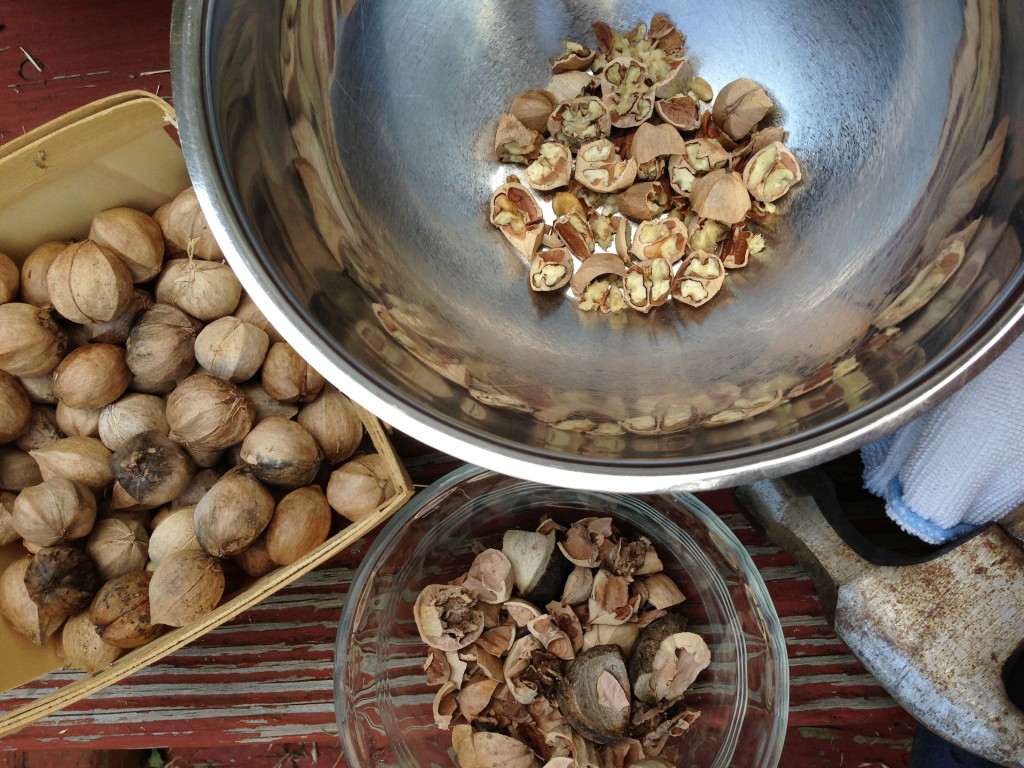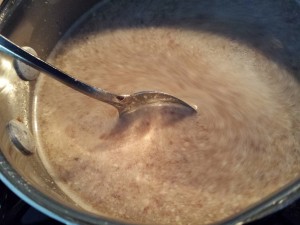
We have a few mature Shaggy Bark Hickory trees on the property at Half Hill Farm that cover the ground each Fall with lots of nut husks. The nut is viewed as the best of America’s Hickory trees, and the squirrels here love them.
 I was curious if there were any old Native American recipes using the nuts and came across some very obscure references to Cherokee Kenuche balls, ground up Hickory nuts (shell and meat) formed into a fist-sized ball that stores well through the Winter and is used on special occasions in soups by the American Cherokee Tribe. I can imagine many food uses and plan on putting a small grape-sized ball in our coffee maker in the morning.
I was curious if there were any old Native American recipes using the nuts and came across some very obscure references to Cherokee Kenuche balls, ground up Hickory nuts (shell and meat) formed into a fist-sized ball that stores well through the Winter and is used on special occasions in soups by the American Cherokee Tribe. I can imagine many food uses and plan on putting a small grape-sized ball in our coffee maker in the morning.
The aroma of Kenuche is meant to guide the ancestors back to special family gatherings where it is served as a side dish. My guess is that memories of gathering and processing the nuts with older family members who have since passed is how ancestors are connected with this very special dish. After the time consuming process of crushing the nuts earlier today, I imagine this was a task for older family members and children who helped pick out larger shells before crushing them. It’s a beautiful side dish with a rich heritage that I’m guessing has less than 40 references online, including books.


Here is how you can make your own Kenuche. We could only gather about 100 Shaggy Bark Hickory nuts because the squirrels favor this nut over everything else. I crushed each one with a hammer. Half of them were bad, so I ended up with only 50. I picked out the larger shell pieces and left the rest in a bowl. I then took a small mortar & pestle and mashed the shells and meat into an oily paste. It’s OK and easier to leave the shells, and this is how it was traditionally done (but in a large hollowed wooden bowl).


Form the resulting Hickory nut paste into a Kenuche ball using wax paper. I find wax paper keeps the oils in the ball instead of sticking to your hand. Kenuche balls are usually the size of a fist, but ours was the size of a plum. You might need 300-400 nuts for a fist-sized Kenuche ball.
You can store Kenuche in the fridge or freezer until you’re ready to use it. Our ball was about 2 ounces, so I simmered it in a half quart of water for about 30 minutes until the nut meat was dissolved into a creamy sauce. A normal sized Kenuche ball would use about a half a gallon of water. I then strained the creamy broth through a sieve and discarded the small shell pieces and added hominy to the resulting broth. We added mushrooms and let this simmer. You can add venison or pretty much anything (brown sugar and maple syrup will make a sweet version and compliment the nutty flavor), but traditional Kenuche soup is the broth with hominy.
Life is all about having the patience to crack a tough nut to get to the good stuff. If your traditional gatherings are starting to focus more on the hollow and commercial aspects of life, who’s bringing what to the table, try infusing traditions that bring people together and create memories of those who have passed. You just might bring more to the table in a humble bowl of soup than you expected.

Thank-you for this post. I am making vegetable broth this morning then wondered if I should throw a whole hickory nut in, so I did. Then I googled hickory nut soup. So glad to learn about this tradition. Wish I knew this at Thanksgiving. Well, next year, though I think our trees will be taking a break in 2014. I supposed I can freeze the 2013 nuts.
It is a windfall year for Hickory nuts here at Yan Jing’s Meadow. Even the squirrels and deer have not finished them, there is a carpet of nuts I stumble over each morning.
I think adding a few hickory nuts could thickening and add an interesting flavor to your broth. I would simply smash them and put them in a muslin bag to remove the shells. It’s very hard to pick the meat out of the shells. If you can, that would be best and they will dissolve into your broth. I’m glad you enjoyed the posting!
Fabulous idea! That will be tomorrow’s broth. Thanks again.
Pingback: The Art of Food: Keeping it Indigenous – Center of the Universe
I enjoyed so much seeing the pictures of your work at Half Hill Farm. If I had a life to live over I would come to Tennessee and buy me a farm. ML Hunt
Thanks for your interesting post. I value knowing such traditions. One thing I like doing is to toast the whole nuts before cracking them. It makes the kitchen smell great and may enhance the flavor. After that I’ve been making it the lazy way – wrap a nut into a clean rag and then crack it with a hammer and throw shells and all into a pot to simmer. I pour off the broth, keeping what nut meat wants to float to the surface. This wastes a lot of meat trapped in the shells but I don’t have the time to pick out the meat. After reading your post I will crush the pieces into smaller bits. Thanks!
I would love a kanuchi ball. No hickory trees where I live in Oregon. My Family originated in Georgia but was removed to land in Tennessee, then to Oklahoma on the Trail of Tears. I would love to have a taste of our Cherokee home. Do you sell them? Can you ship them.